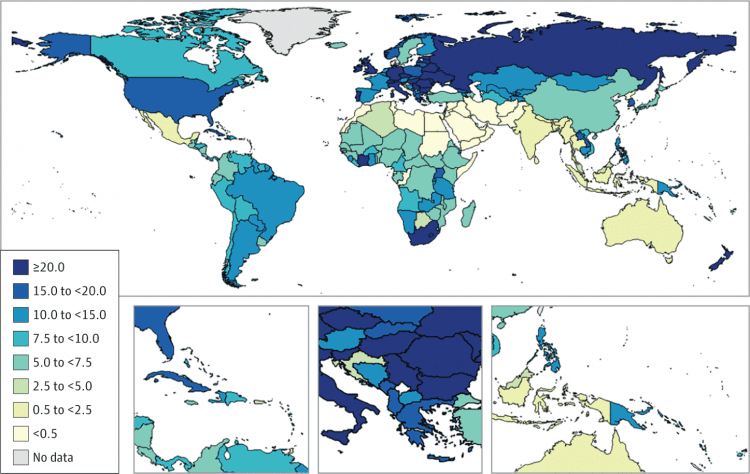Global Prevalence of Fetal Alcohol Spectrum Disorder Among Children and Youth. A Systematic Review and Meta-analysis
Original Investigation
Key Points
Question
What is the prevalence of fetal alcohol spectrum disorder among children and youth in the general population?
Findings
In this meta-analysis of 24 unique studies and 1416 unique children and youth with fetal alcohol spectrum disorder, approximately 8 of 1000 in the general population had fetal alcohol spectrum disorder, and 1 of every 13 pregnant women who consumed alcohol during pregnancy delivered a child with fetal alcohol spectrum disorder. The prevalence of fetal alcohol spectrum disorder was found to be notably higher among special populations.
Meaning
The prevalence of fetal alcohol spectrum disorder among children and youth in the general population exceeds 1% in 76 countries, which underscores the need for universal prevention initiatives targeting maternal alcohol consumption, screening protocols, and improved access to diagnostic services, especially in special populations.
Abstract
Importance
Prevalence estimates are essential to effectively prioritize, plan, and deliver health care to high-needs populations such as children and youth with fetal alcohol spectrum disorder (FASD). However, most countries do not have population-level prevalence data for FASD.
Objective
To obtain prevalence estimates of FASD among children and youth in the general population by country, by World Health Organization (WHO) region, and globally.
Data Sources
MEDLINE, MEDLINE in process, EMBASE, Education Resource Information Center, Cumulative Index to Nursing and Allied Health Literature, Web of Science, PsychINFO, and Scopus were systematically searched for studies published from November 1, 1973, through June 30, 2015, without geographic or language restrictions.
Study Selection
Original quantitative studies that reported the prevalence of FASD among children and youth in the general population, used active case ascertainment or clinic-based methods, and specified the diagnostic guideline or case definition used were included.
Data
Extraction and Synthesis Individual study characteristics and prevalence of FASD were extracted. Country-specific random-effects meta-analyses were conducted. For countries with 1 or no empirical study on the prevalence of FASD, this indicator was estimated based on the proportion of women who consumed alcohol during pregnancy per 1 case of FASD. Finally, WHO regional and global mean prevalence of FASD weighted by the number of live births in each country was estimated.
Main Outcomes and Measures
Prevalence of FASD.
Results
A total of 24 unique studies including 1416 unique children and youth diagnosed with FASD (age range, 0-16.4 years) were retained for data extraction. The global prevalence of FASD among children and youth in the general population was estimated to be 7.7 per 1000 population (95% CI, 4.9-11.7 per 1000 population).
The WHO European Region had the highest prevalence (19.8 per 1000 population; 95% CI, 14.1-28.0 per 1000 population), and the WHO Eastern Mediterranean Region had the lowest (0.1 per 1000 population; 95% CI, 0.1-0.5 per 1000 population).
Of 187 countries, South Africa was estimated to have the highest prevalence of FASD at 111.1 per 1000 population (95% CI, 71.1-158.4 per 1000 population), followed by Croatia at 53.3 per 1000 population (95% CI, 30.9-81.2 per 1000 population) and Ireland at 47.5 per 1000 population (95% CI, 28.0-73.6 per 1000 population).
Conclusions and Relevance
Globally, FASD is a prevalent alcohol-related developmental disability that is largely preventable. The findings highlight the need to establish a universal public health message about the potential harm of prenatal alcohol exposure and a routine screening protocol.
Brief interventions should be provided, where appropriate.
Summary and quotes
Globally, nearly eight out of every 1,000 children in the general population is estimated to have Fetal Alcohol Spectrum Disorder (FASD).
It is estimated that one out of 13 women who consumed any alcohol at any point or frequency during pregnancy delivered a child with FASD.
FASD prevalence estimates are essential to effectively prioritize and plan health care for children with FASD, who are often misdiagnosed,” says Dr. Svetlana Popova, Senior Scientist in CAMH’s Institute for Mental Health Policy Research.
Most of these children will require lifelong care, so the earlier they have access to appropriate therapy and supports, the better their long-term health and social outcomes will be.”
FASD is an umbrella term that describes a range of effects that can occur in someone whose mother consumed alcohol during pregnancy.
As the fetus develops, the brain is particularly vulnerable to alcohol’s damaging effects, which can lead to physical, mental, behavioral and learning disabilities.
For many countries, these are the first-ever estimates of FASD.
Some notable figures:
- Canada has eight cases of FASD per 1,000 children
- The U.S. has 15 cases of FASD per 1,000 children
- The European Region has the highest levels worldwide, at nearly 20 cases of FASD per 1,000 children
- The Eastern Mediterranean Region has the lowest FASD prevalence
- In 76 countries, more than one out of 100 young people has FASD.
- FASD occurred more frequently among children in care (such as foster care or orphanages), in the criminal justice system, in psychiatric care and aboriginal young people, compared to the general population.
There is a need for targeted screening and diagnosis for these high-risk populations, as well as interventions to prevent alcohol use among mothers of children with FASD in relation to subsequent pregnancies,” says Dr. Popova.
